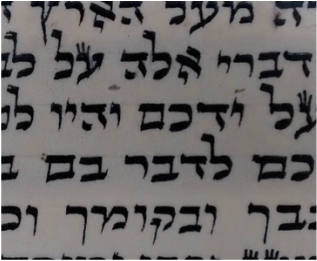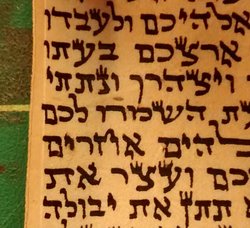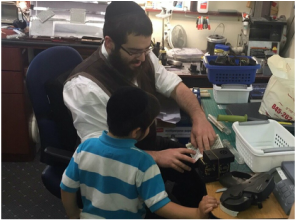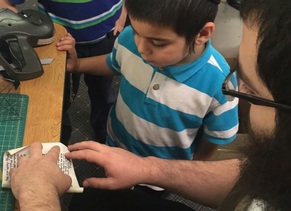|
There are times that we are required to show a letter with a questionable status to a child who knows the Alef Beis well, but does not yet know how to read.
Why? For only he or she can judge the letters objectively and not be influenced by reading the letter in the context of the word. Only they can reveal what this letters status really is.
0 Comments
 This Mezuzah was written sloppily and and as you can see here there is a very interesting scenario. What is the problem? We have the Yud of ידכם and the Vov of והיו and they are practically the same length. A short vov (depending how short) is technically a Yud and a long Yud (depending on length) is a vov. Usually each Shaloh is presented individually and judged accordingly and in context to the Ksav... However here we have a Vov and a Yud practically the same length and one after the other. This makes it a bit more difficult because they can't both be Kosher. The result? I bought this to a Rav who Paskend that the Vov was to short and this Mezuzah is not Kosher.  When two letters are touching form a different letter completely in most cases the Mezuzah can not be fixed. There are two reasons for this: 1) The letters need to be written not scraped. it says in the Torah Uchesavtom "you shall write" not :you shall scrape: since the Reish and Vov lost their form in creating the Ches we cannot just separate them because we would be recreating these letters through scraping as opposed to writhing. 2) We cannot erase these letters completely to rewrite them because a Mezuzah needs to be written in order. It says “Vehoyu” and the Medresh explains “Behaviosom Yihiyu” which means that the order that the letters are in the Torah is the order that they have to be written in, so if for example the Sofer wrote the word of Shemah and then he realized that the shin was Possul he cannot just correct it he must first erase the Ayin and the Mem then correct the Shin and start again. (If Hashems name is written after the mistake it cannot be corrected, because in order to correct you would need to erase all written after the mistake and Hashems name cannot be erased) in this particular case the letters are technically not Reish and Vov but it is a Ches. If we were to separate them or even erase and rewrite them we would be creating a Reish and a Vov "out of order" |

CASE STUDIES
Check out my YouTube channel for the latest updates Many things can render Tefillin or Mezuzah not Kosher or at best minimally Kosher. Some of these happen over time with aging and some unfortunately are Posul from the get go. Such as, Letters, words and or Tagim that are missing, extra substituted, touching, Broken, Improperly Spaced, misshapen faded, cracked and weather damaged. We document the problems we find and periodically upload them to the website. We hope that this will educate and encourage the public to purchase only Tefillin and Mezuzas that are high quality from a reputable source, to take care of them properly and have them checked regularly. Categories
All
AuthorRabbi Kass was ordained by Rabbi Yisrael Meir Lau, former Ashkenazik Chief Rabbi of Israel. He is certified as a Sofer for both Kesivah and Hagoah by one of the leading experts in Safrus, Rabbi Avrohom Tzvi Vosner, Rav of the Vad Mishmeres Sta”m. Archives
December 2023
|
What our clients say about us: |
To enhance our service quality, we operate on an appointment-only basis.
Please contact us to make an appointment. $12.99 Flat rate shipping! Mezuzahs, Tefillin & Accessories! |
|





 RSS Feed
RSS Feed




